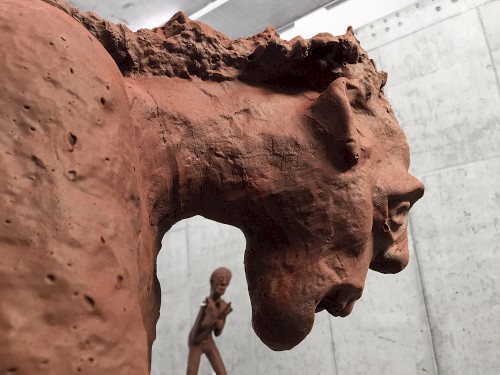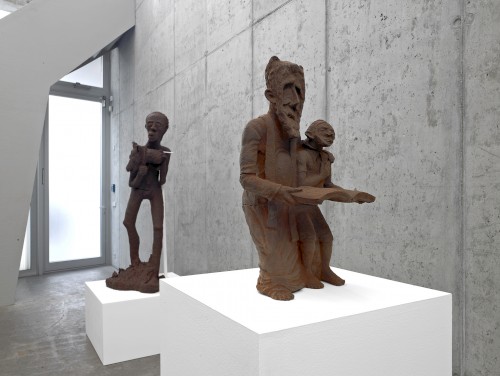We are pleased to announce Dutch artist Renzo Martens’s first solo exhibition in Germany. The Institute for Human Activities (IHA), which Martens directs, presents recent sculptural work by the Cercle d’Art des Travailleurs des Plantations Congolaises (Congolese Plantation Workers Art League). Once upon a time, the expressive energy of Congolese sculpture inspired the European avant-garde. A lively trade in these artifacts scattered them throughout the world’s museum collections, while the colonial occupation of the Congo more than a century ago brought local artistic production to a halt. Since 2012, IHA has worked to establish an artists’ colony near a former Unilever plantation in the rainforest 500 miles east of Kinshasa. Subsistence farmers and plantation workers have begun to create self-portraits. Seven new sculptures they created in January 2015 now have their public premiere at KOW.
Wir freuen uns Renzo Martens erste Einzelausstellung in Deutschland anzukündigen. Das von Martens geleitete Institute For Human Activities (IHA) präsentiert neueste Skulpturen des Cercle d’art des Travailleurs des Plantations Congolaises (Congolese Plantation Workers Art League). Einst beflügelte die Ausdruckskraft kongolesischer Skulpturen die europäische Avantgarde. Reger Handel verteilte sie auf Museumssammlungen weltweit, während gleichzeitig die künstlerische Produktion vor Ort im Kongo mit der kolonialen Besatzung vor über hundert Jahren endete. Nun initiiert IHA seit 2012 eine Künstlerkolonie 800 Kilometer östlich von Kinshasa, nahe einer ehemaligen Unilever-Plantage im Regenwald. Subsistenzbauern und Plantagenarbeiter haben hier damit begonnen, Selbstportraits anzufertigen. Sieben Plastiken, die im Januar 2015 entstanden, zeigen wir nun erstmals bei KOW.
It seems, so far, as if no artistic critique of living and working conditions in the Congo changes those conditions. On the contrary, such art is apt to reinforce global inequality: poverty and exploitation provide the raw material for a critical cultural production that ultimately generates jobs and profits in metropolitan cities like London and Berlin rather than in Kinshasa, let alone on the remote plantations. Martens’s widely discussed film Episode III: Enjoy Poverty, which was shot in the Congo between 2004 and 2008, showcased this mechanism – and yet also fed into it. With their new initiative, Martens and IHA now examine whether this mechanism can be turned on its head. Can artistic critique yield its economic and social benefits in the places it discusses; places where these benefits – money and self-determination – are urgently needed? IHA’s art center is the point of origin for a new generation of artists and an aesthetic production in which plantation workers give lasting form to their feelings and their critique of the circumstances in which they live, reviving repressed cultural traditions and reliving them through present-day conditions.
The cooperation between the Congolese Plantation Workers Art League and the Institute for Human Activities aims to foster local economic diversification while also bringing the resulting works of art to the attention of audiences worldwide; IHA will coordinate their international distribution. Digital scans of the original clay sculptures created this January were transmitted to Amsterdam, the world’s largest port of transshipment for cocoa, where a 3D printer produced replicas of the originals. Chocolatiers then manufactured Belgian chocolate casts from this secondary prototype. Some of the raw cocoa that went into the chocolate came from plantations near the Congolese settlement; besides palm oil and rubber, cocoa constitutes the only connection between world markets and these workers, their only medium of global communication. Where a pound of cocoa beans usually represents a value of approximately US$0.25 to these workers, who earn monthly wages of around $20, the same pound of cocoa fetches hundreds of times as much if emotions are added and the chocolate is inscribed into the art market.
Künstlerische Kritik an den Lebens- und Arbeitsbedingungen im Kongo scheint an diesen Bedingungen bislang nichts zu ändern. Die globale Ungleichheit wird im Gegenteil noch einmal zementiert, wo Armut und Ausbeutung den Rohstoff für eine kritische Kulturproduktion liefern, die letztlich Jobs und Profite in Metropolen wie London und Berlin generiert, nicht in Kinshasa oder gar auf den entlegenen Plantagen. Renzo Martens weithin diskutierter Film „Episode III: Enjoy Poverty“, der 2004 bis 2008 im Kongo entstand, führte diesen Mechanismus exemplarisch vor – und entsprach ihm doch selbst. Mit ihrer Initiative fragen Martens und IHA nun, ob er sich umkehren lässt. Kann künstlerische Kritik ihre ökonomischen und sozialen Effekte an den Orten entfalten, über die sie spricht, und an denen diese Effekte, Geld und Selbstbestimmung, dringend gebraucht werden? IHAs Kunstzentrum ist der Ursprungsort einer neuen Künstlergeneration und ihrer ästhetischen Produktion, in der Plantagenarbeiter ihre Gefühle und die Kritik an ihren Lebensumständen ins Werk setzen und dabei unterdrückte kulturelle Traditionen wieder aufgreifen und unter veränderten Vorzeichen weiterentwickeln.
Die Kooperation zwischen der Congolese Plantation Workers Art League und dem Institute for Human Activities zielt auf eine nachhaltige Entwicklung vor Ort und zugleich auf eine internationale Rezeption und Distribution der entstehenden Werke, die das IHA koordiniert. Die im Januar entstandenen Plastiken wurden aus Tonerde gefertigt, eingescannt und aus den digitalen Datensätzen in Amsterdam, dem größten Kakao-Umschlaghafen der Welt, von einem 3D-Drucker reproduziert. Abgüsse dieser zweiten Urform wurden von Chocolatiers in belgischer Schokolade gefertigt. Der Rohstoff für diese Schokolade stammt unter anderem aus den umliegenden Plantagen im Kongo und ist neben Palmöl und Kautschuk die einzige Verbindungslinie zwischen dem Weltmarkt und den Arbeitern, ihr einziges Medium der globalen Kommunikation. Entspricht ein Kilogramm Kakaobohnen für sie üblicherweise einem Wert von etwa 25 Cent – bei einem Monatseinkommen von rund 20 Euro – repräsentiert das gleiche Kilo einen mehrere hunderfach höheren Wert, wenn ihm Emotionen hinzugefügt werden und die Schokolade auf den Kunstmarkt gehandelt wird.

The work on the plantations is not enough to live on, and so the workers now make a living by engaging critically with the work on the plantation. The Plantation Workers Art League collects profits from the sculptures’ sale and use them to supplement the artists’ incomes and improve the local infrastructure. In addition to the editions offered by KOW, IHA distributes two unlimited multiples (BUY HERE FOR €39.95). Concurrently with our exhibition, Martens and IHA will set up a project space at the KW INSTITUTE FOR CONTEMPORARY ART, where they will build new partnerships as well as hold talks and public events to flesh out the initiative’s discursive framework. KW, which grew out of a similar cultural producers’ initiative within the Berlin context, is a great place to focus resources and debates and harness them for developing the Congolese project. This presentation of the work of Renzo Martens, who originally built his reputation on conceptual films, is the sixth chapter of KOW’s ONE YEAR OF FILMMAKERS exhibition series.
Text: Alexander Koch / Translation: Gerrit Jackson / Editing: Kimberly Bradley / Photos: Ladislav Zajac
Von der Plantagenarbeit können die Autorinnen und Autoren der Werke nicht leben, also leben sie nun von der kritischen Auseinandersetzung mit Plantagenarbeit. Gewinne aus dem Verkauf der Skulpturen gehen an die Plantation Workers Art League und ändern Einkommen und Infrastruktur vor Ort. Neben den Editionen, die KOW anbietet, vertreibt IHA zwei unlimitierte Multiples, die zum Preis von 39,95€ erhältlich sind (HIER BESTELLEN). Zeitgleich mit unserer Ausstellung eröffnen Renzo Martens und IHA einen Projektraum in den KW INSTITUTE FOR CONTEMPORARY ART. Während fünf Wochen sollen hier Partnerschaften geknüpft und Gelder eingeworben werden, aber auch zahlreiche Gespräche und öffentliche Veranstaltungen den diskursiven Rahmen der Initiative abstecken. KW, einst selbst aus dem Engagement von KulturproduzentInnen entstanden, kann Ressourcen und Diskussionen bündeln und für die Projektentwicklung im Kongo nutzbar machen. KOW zeigt Renzo Martens, bislang als konzeptueller Filmemacher bekannt, als sechstes Kapitel der Ausstellungsreihe ONE YEAR OF FILMMAKERS.
Text: Alexander Koch / Fotos: Ladislav Zajac









- Current
- Upcoming
- 2026
- 2025
- 2024
- 2023
- 2022
- 2021
- 2020
- 2019
- 2018
- 2017
- 2016
- 2015
- 2014
- 2013
- 2012
- 2011
- 2010
- 2009